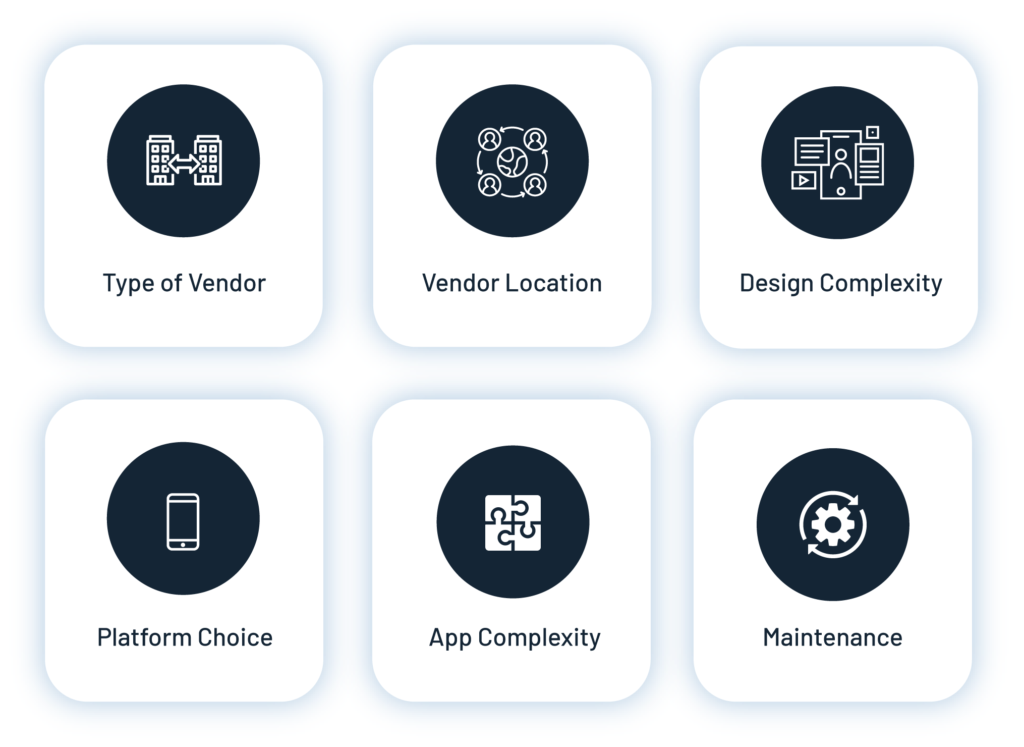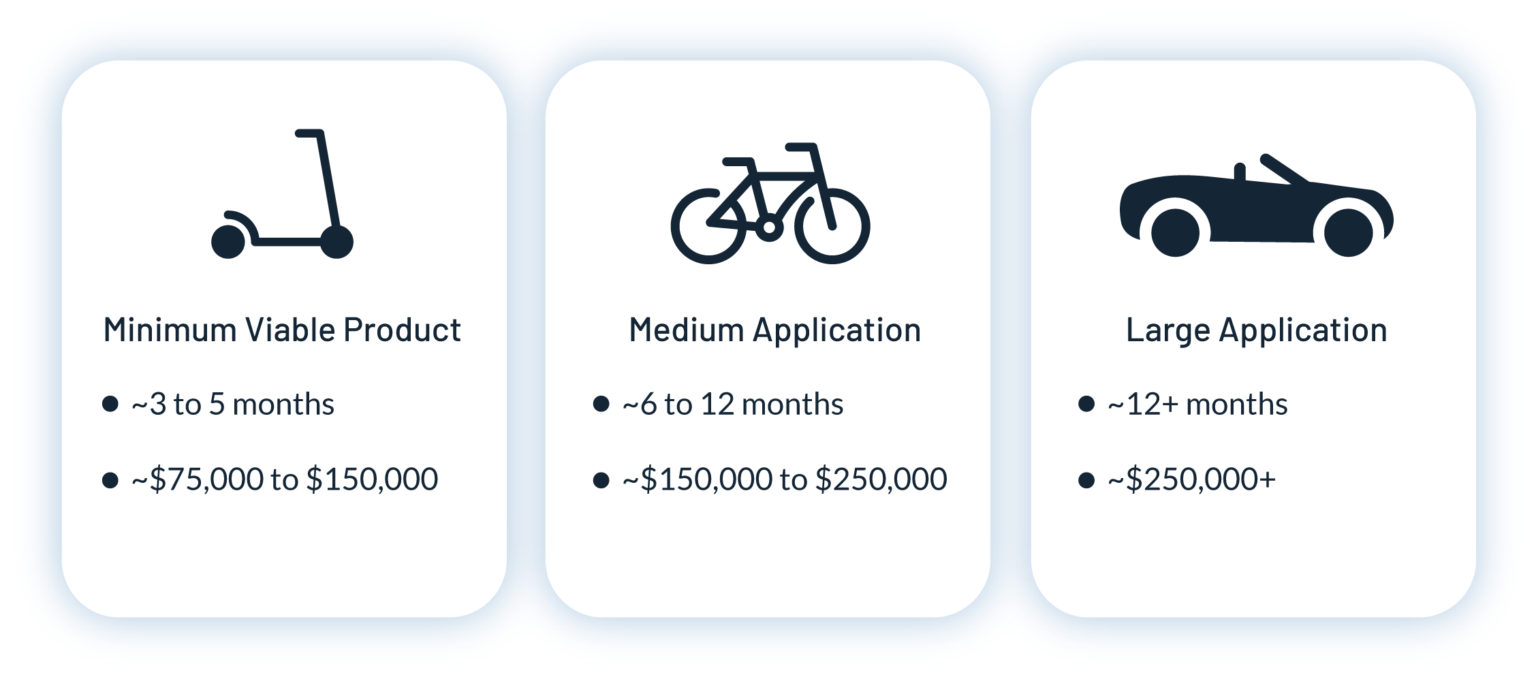How much does mobile app development cost? This question is top of mind for many, from entrepreneurs and founders to the enterprise C-suite. And it’s a complicated question because the cost to develop an app depends on a wide variety of factors ranging from project size to technical complexity to your choice of a development partner.
This article provides a detailed overview of everything that contributes to mobile app development costs. This article supports Clearbridge Mobile’s Definitive Guide to Mobile App Costs Infographic, and together form a complete guide to understanding mobile app development costs.
Factors that Determine Mobile App Development Costs
Several factors determine mobile app development costs, and the reality is, looking at approximate price ranges alone is not an accurate enough estimate. The project scope is a very significant cost factor, but several other facets influence complexity, difficulty, timeframe, and, therefore, price. Below are the factors that most significantly impact mobile app development costs.
- Type of Vendor
- Vendor Location
- Design Complexity
- Platform Choice
- App Complexity
- Ongoing maintenance and support
1. The Type of Vendor
Your choice of development partner will impact how much you pay. There are three main types of vendors: independent or small development shops, specialist app development firms, and large consulting firms.
Independent or small development shops fall into categories that include individual freelancers and small shops that consist of a handful of people. These developers are the cheapest (onshore) option for developing a mobile app. In many cases, the development talent is there. However, these vendors have significant knowledge gaps, including user experience design competency, product strategy, business analysis, marketing expertise, and other vital areas that ensure a mobile app is successful and not just functional.
Specialist app development firms focus specifically on building mobile solutions for businesses. They bring a breadth of technical expertise and specialized platform knowledge, emphasize product strategy and design, and employ an agile development methodology. Developing an app with one of these firms is cheaper than large firms and more expensive than using independent developers or small development shops.
Large consulting firms are usually branches of large multinationals with diverse business lines (think IBM) and sometimes larger technology companies. They have strong technical expertise and development capabilities. Still, They may have disadvantages that include a lack of flexibility to respond to project needs quickly and an inability to ramp-up as fast as other development firms. Large firms, in the majority of cases, have the highest mobile app development costs.
2. Vendor Location
You can find the approximate hourly rates for development worldwide in the chart below.
North American (U.S. and Canada) development rates are generally the highest comparatively, with expenses ranging from $20 to $250 an hour. With that said, the final product quality and overall experience are incomparable, and customer service is at a distinct advantage. While you pay more for North American development, it’s essential to work with a partner that’s accessible and flexible in real-time. When you work with a partner in the same time zone, you get constant communication and support. If an issue arises, you can work through the problem without delay. It may not seem like a roadblock, but communication errors of any kind, no matter how small, add up to a slower time-to-market and incur unnecessary costs.
The decision to outsource mobile app development to an offshore firm is generally made due to budgetary constraints. These firms are significantly cheaper; however, many red flags come with cost savings. Offshore firms tend to fall short in many significant areas, including:
- Technological and design standards
- The overall quality of work
- The ability to deliver
- Inadequate security and IP protection
- Responsiveness and communication due to substantial time differences
3. Design Complexity
The design process in mobile app development is intensive, but any industry expert will warn against trying to cut costs on user experience—and for a good reason.
In the face of user experience, design, and usability issues, people experience stress, frustration, anger, and anxiety. These types of reactions are disastrous for companies, mainly because 63 percent of consumers will actively try to discourage others from using a service or brand if they’ve had a bad mobile experience. Customers are unforgiving and are becoming increasingly inflexible when they encounter a poor design.
Most quality development firms will offer design thinking services that lay the entire foundation of a product’s user experience and typically go way beyond how a mobile app looks on a screen. A design thinking and product strategy session can range from $15,000 to $25,000 plus, and that price can vary depending on the design’s complexity.
Investing in excellent product strategy design services will, without question, save money in the long run. This stage of development creates enough time to make changes to critical design issues before the product reaches development, and it becomes too late (and too expensive) to make major changes to the UX.
Consider the image above; if you only start thinking critically about an “almost-finished” product, you run the risk of finding serious issues too late to make changes. Design research is the mitigator – you’ll spend less if you do upfront research. The closer you get to launch, the more expensive changes are. Conduct design research early and iteratively to ensure the product is easy and enjoyable to use and to align all strategic design decisions to user needs and safeguard the project’s ROI.
4. Platform Choice
There is nothing inherent to either iOS development or Android development that makes one more expensive than the other; however, if you need to accommodate both operating systems, be prepared to spend more money. Building companion apps for wearables or connected TV platforms will also increase total mobile app development costs, though usually not to the same degree.
Device support also affects the cost of developing an app in two ways:
- The type of device: Phones, tablets, TVs, smartwatches, etc.
- The device generation: Supporting older devices with older operating systems requires more development effort.
In most cases, apps are built primarily for smartphones and tablets, and most development firms ensure that older generation devices (within a reasonable timeframe) are supported. If you expect your app to go beyond the common standards, the cost to develop an app will increase.
5. App Complexity
Apps can vary significantly in terms of size and complexity.
Functions, features, and user flow refer to actions users will take within the app and the technologies they need to facilitate these actions. Products with many features are more complex and challenging to develop and therefore increase mobile app development costs.
To offer an example of how mobile app scope can add up, here’s a small list of mobile app features.
- Registration and login
- With email
- With social media
- Forgot password or restore password criteria
- Log out
- Profile creation and editing
- Set region
- Add or change photo
- Add or change information
- Change email address
- Search
- Messaging and chat
- Conversation details
- Conversation feed
- Online/offline status
- Message alerts or push notifications
- Typing status
- Read receipts
- Sending media files and documents
- Payments
- Users can pay with a credit card
- Users can pay with Apple Pay, Android Pay, PayPal, Venmo, or other mobile wallet options
- Check balances
- Check transaction history
- Add and remove payment options
- In-app purchases
- Basic Admin Panel for user management
- See a list of users
- Edit users
- Delete or block users
- Creating new users
- Basic Admin Panel of payment processing
- See a list of payments
- Refund payments
- Basic Admin Panel for push notifications
- Send custom push notifications
- Analytics
- Use of device hardware
- NFC
- Bluetooth
- Camera access
- Microphone access
- Barometers
- Accelerometers
- Geolocation
- Map Integrations
- Detect a user’s location
- Search on a map
- Set location points
- Video and Audio Streaming
- Start and stop content
- View content
- Switch between content streams
- Offline mode
As you can see from the list above, choosing the best features for your mobile app is not as straightforward as it seems. With each selected feature, a whole series of other requirements and considerations unfold. With that said, it is possible to de-scope the size of the app, go to market first with a minimum viable product, or roll out features on an iterative basis in phases to reduce upfront costs.
The minimum viable product (MVP) development method tests the minimal form of your product. This strategy allows your team to validate product assumptions and learn how your target market experiences and reacts to the app’s core purpose. This approach will provide insight into appropriately allocating your budget to areas that best satisfy your overall business objectives. Building an MVP is an iterative process designed to identify user pain points and determine the proper product functionality to address those needs over time. Typically, MVPs are developed over three to five months and can cost anywhere from $75,000 to $100,000, but are the least expensive approach to mobile app development.
6. Ongoing Maintenance and Support
App development doesn’t end after the initial launch of an app. It’s not uncommon for a mobile app to be considered “outdated” in 6-8 months if left unattended. Without recurring maintenance, rework, updates, and additions, the gap between customer needs and product value grows too wide to achieve business objectives. With a market that’s so densely saturated, it’s very easy for customers to switch to higher-quality alternatives.
At a minimum, you need to plan for the cost of maintaining your app to fix bugs and meet system upgrade requirements. If you want sustained success, you need to have a longer-term product vision that accounts for user demands; roll out product improvements or new features, and remain relevant in an increasingly competitive market. While it’s rare for companies to nail this down in their initial budgeting plans, it’s prudent to forecast the six months, one year, and even 2-year costs associated with maintaining and improving your product.
In many cases, the cost to maintain an application can account for 15 percent to 20 percent of the original price of development. Even if you don’t plan to scale or introduce additional features, maintenance is essential for the following:
- Bug fixes
- Improving stability and performance
- Code optimization
- Adding support for new operating systems
- Supporting the latest versions of third-party services
The Breakdown of Mobile App Development Costs
So, how much does it cost to build an app? If you’ve stayed with us this far, you know that there are many variables to take into account. Mobile app development costs differ on a case-by-case basis. There is a huge variety in the cost to develop a mobile app, with factors like complexity, scope, features needed, and even the type of firm used affecting price. Ultimately, the cost to develop an app depends on what the app is and what it needs to do.







